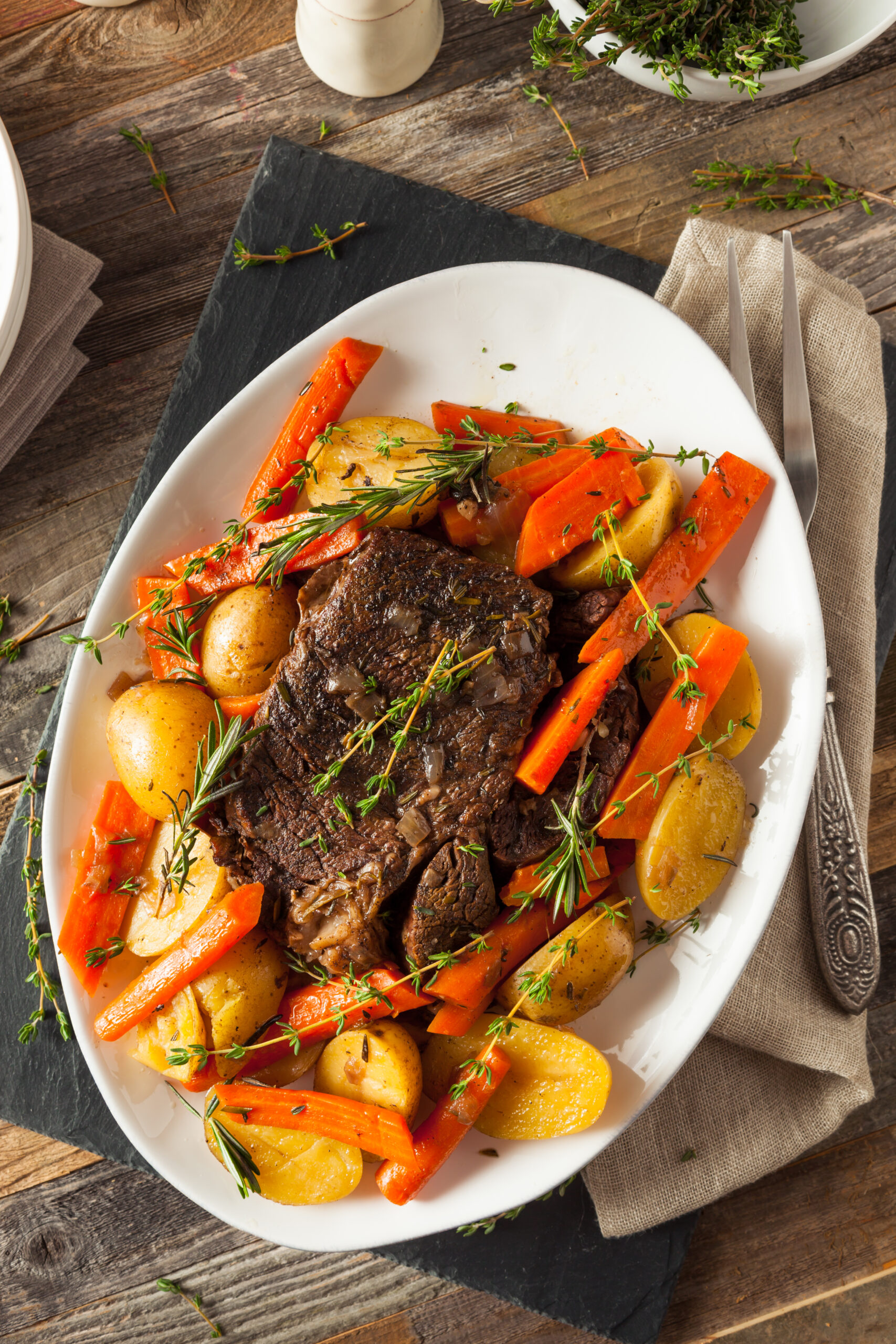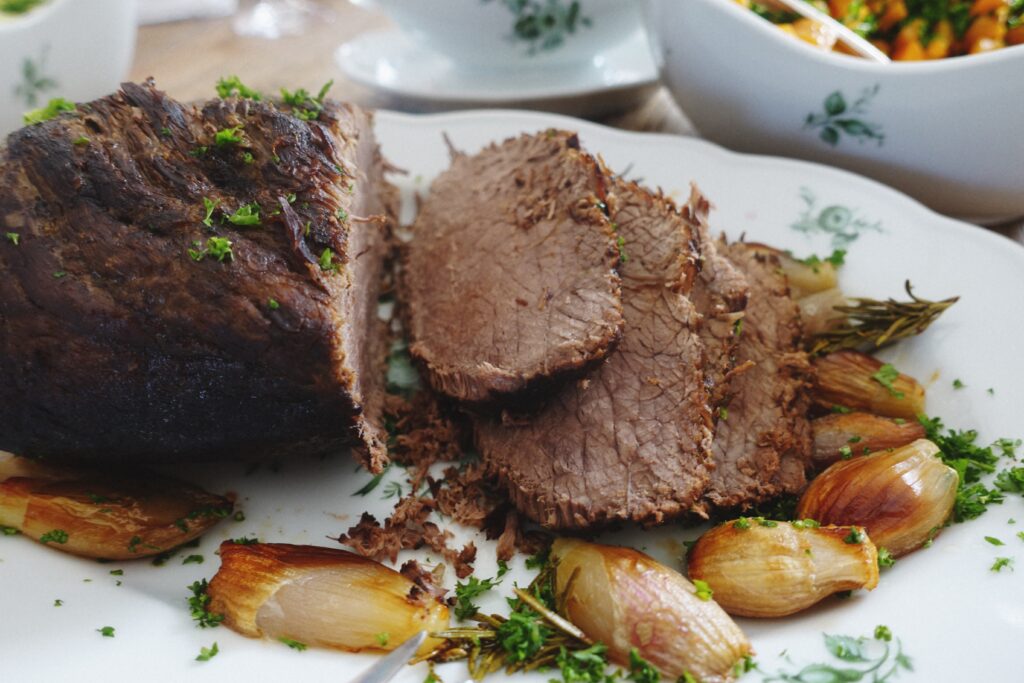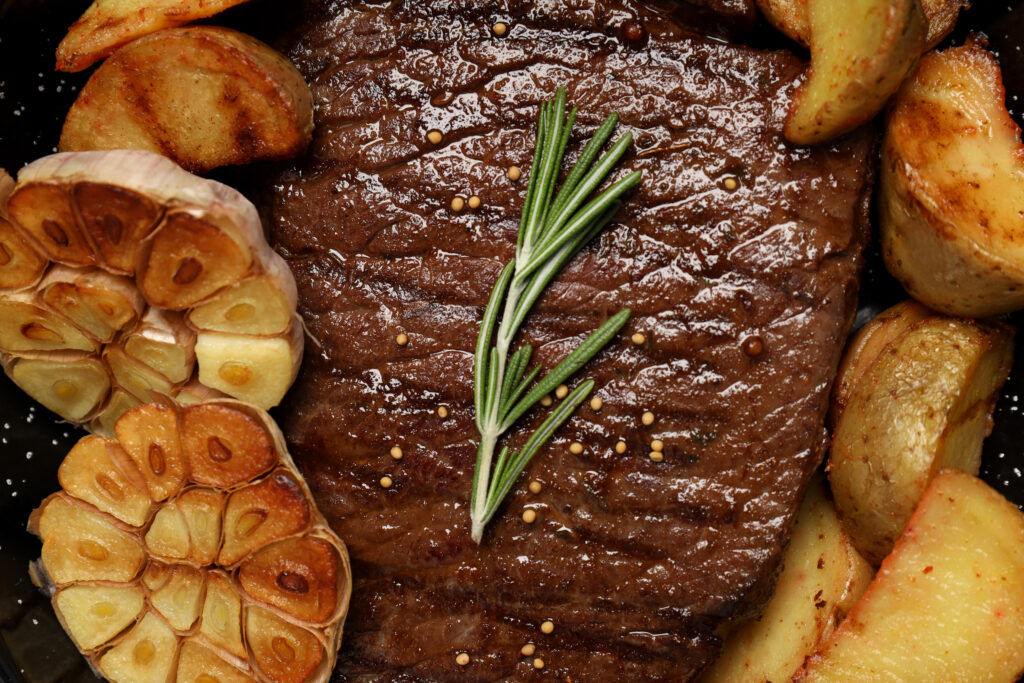What is Chuck Roast?
is a popular beef cut known for its rich flavor and suitability for slow cooking. This cut comes from the chuck section of the animal, including parts of the neck, shoulder blade, and upper arm. The chuck area provides cuts rich in fat and connective tissues. These features make them ideal for slow cooking methods like braising or pot roasting.
You can find common chuck cuts such as the chuck eye roast, which is slightly more tender, and the shoulder pot roast. Cooks prefer to prepare these cuts slowly. This method allows the tough connective tissues to break down, which makes the meat tender and flavorful. Chuck roasts are essential in many kitchens, used in recipes like stews and pot roasts to add depth and richness to the dish.
Cooking Methods
thrives under slow-cooking methods that tenderize its tough muscle fibers and connective tissues, enhancing its natural flavors. Two of the best techniques for preparing chuck roast are braising and slow cooking.
Braising involves cooking the chuck roast with a small amount of liquid in a covered pot at a low temperature. Don’t miss our guide on how many hours do you cook a chuck roast for perfect tenderness. This method not only tenderizes the meat but also allows it to absorb the flavors of the liquid and aromatics, resulting in a juicy, flavorful dish. To braise chuck roast, you typically sear the meat first to develop a flavorful crust, then cook it slowly in a flavorful broth along with herbs and vegetables.
Slow cooking is another ideal method, especially for those who prefer a more hands-off approach. Using a slow cooker, you can cook chuck roast on a low setting for several hours. This gentle cooking process ensures that even the toughest cuts of chuck roast become delightfully tender. Moreover, slow cooking in a crockpot or similar appliance allows the meat to cook in its own fat and juices, enhancing the overall flavor and texture.
Recipes
is incredibly versatile, making it a staple in various culinary traditions. Here are some popular recipes that showcase its potential:
Classic Pot Roast: This traditional recipe involves slow-cooking the chuck roast with potatoes, carrots, and onions, all seasoned with herbs like rosemary and thyme. The result is a comforting, all-in-one meal that’s perfect for a family dinner.
Beef Stew: Another favorite, this recipe uses bite-sized pieces of simmered with vegetables in a rich, savory broth. It’s an ideal dish for cold weather, providing warmth and hearty flavors.
Barbecue Beef Sandwiches: For a more casual take, slow-cook until it’s pull-apart tender, then shred it and toss with barbecue sauce. Serve the meat piled high on soft buns for a delicious and satisfying meal.
These recipes not only bring out the best in chuck roast but also provide comforting and hearty dishes that are perfect for any occasion. Looking for inspiration? Try our beef shank recipe for another slow-cooked favorite. Whether braised, slow-cooked, or stewed, offers a range of possibilities for any home cook.
To explore further, check out which cooking method is best for a chuck roast for expert tips on achieving the perfect texture and taste.
Nutritional Benefits
Nutritional Content
is not only flavorful and versatile but also offers substantial nutritional benefits. It’s rich in proteins, essential for muscle form and growthA typical serving contains a high amount of complete protein, which includes all the essential amino acids required by the body.
In terms of fat content, has a moderate amount, which includes both saturated and monounsaturated fats. These fats contribute to the taste and texture of the meat while also providing a source of energy.
Furthermore, is a good source of important vitamins and minerals. It is particularly rich in iron, which is crucial for forming red blood cells and preventing anemia. It also contains zinc, important for a healthy immune system and proper cell function.
Additionally, chuck roast provides B vitamins, particularly vitamin B12, which supports nerve function and the production of DNA and red blood cells. Selenium, another mineral found in chuck roast, plays a key role in metabolism and thyroid function.
Overall, can be a valuable part of a balanced diet, offering multiple nutritional benefits that are essential for maintaining good health.
Nutritional Benefits of Chuck Roast
Health Benefits
Consuming offers several health benefits, largely due to its high protein content and rich array of essential nutrients. Here’s how including chuck roast in your diet can contribute to your health. Learn more about the health benefits of beef from the World Health Organization.
High Protein Content: excellent source of high-quality protein, which is vital for building and repairing muscles, skin, and other body tissues. Protein also plays a crucial role in producing enzymes and hormones in the body, making chuck roast a great option for maintaining muscle mass, especially in aging individuals.
Rich in Iron: Iron is another key nutrient . This mineral is essential for making hemoglobin, the protein in red blood cells that carries oxygen around the body. Regularly consuming iron-rich foods like chuck roast can help prevent iron-deficiency anemia and boost energy levels.
Source of Essential B Vitamins: includes several B vitamins, particularly vitamin B12, niacin, and riboflavin. Vitamin B12 is crucial for neurological function and DNA production. Niacin helps convert food into energy and plays a role in skin and nerve health, while riboflavin supports energy production and cellular function.
Contains Zinc and Selenium: The zinc found in chuck roast boosts the immune system and aids in wound healing and cell division. Selenium, another mineral present in this meat, is important for reproductive health, DNA production, and protecting the body against infections and oxidative damage.
Supports Heart Health: Despite containing saturated fats, moderate consumption of chuck roast can be part of a heart-healthy diet when paired with a variety of other protein sources and plenty of vegetables. The monounsaturated fats in chuck roast can also support cardiovascular health.
Including chuck roast in a balanced diet can thus contribute significantly to overall health by providing essential nutrients that support various bodily functions and help maintain physical well-being.

What is chuck roast good for?
- Total Time: 4 hours 20 minutes
- Yield: 6 servings 1x
Description
Discover what chuck roast is good for, its cooking methods, health benefits, and why it’s a kitchen essential. Perfect for braising, slow cooking, and hearty meals.
Ingredients
- 3 lbs chuck roast3 lbs chuck roast
- 2 tbsp olive oil
- 1 tsp salt
- 1 tsp black pepper
- 1 onion, chopped
- 4 carrots, cut into chunks
- 4 potatoes, cut into chunks
- 4 cups beef broth
- 3 garlic cloves, minced
- 2 sprigs fresh rosemary
- 2 sprigs fresh thyme
Instructions
- Preheat Oven: Set to 325°F (163°C).
- Season Roast: Rub salt and pepper over the chuck roast.
- Sear the Meat: Heat olive oil in a Dutch oven over medium-high heat. Sear roast on all sides until browned.
- Add Vegetables: Add onion, carrots, and garlic. Sauté for 3–4 minutes.
- Add Broth and Herbs: Pour in beef broth, add rosemary and thyme.
- Cover & Cook: Cover the pot and place in the oven for 3–4 hours, or until the roast is fork-tender.
- Serve: Slice or shred the beef, serve with vegetables and gravy.
Notes
- For slow cooker: Cook on LOW for 8–10 hours or HIGH for 5–6 hours.
- Add red wine for extra depth of flavor.
- Leftovers make excellent sandwiches!
- Prep Time: 20 minutes
- Cook Time: 4 hours
- Category: Main Dish
- Method: Braising / Slow Cooking
- Cuisine: American












